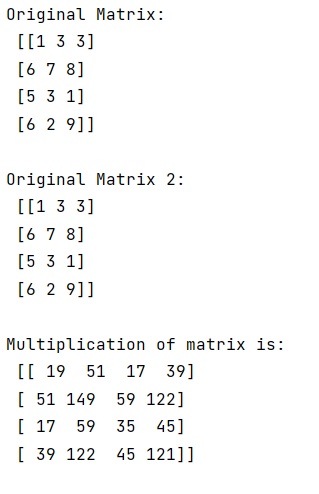Home »
Python »
Python Programs
How does multiplication differ for NumPy Matrix vs Array classes?
Learn how to subsample every nth entry in a NumPy array in Python?
By Pranit Sharma Last updated : October 08, 2023
NumPy is an abbreviated form of Numerical Python. It is used for different types of scientific operations in python. Numpy is a vast library in python which is used for almost every kind of scientific or mathematical operation. It is itself an array which is a collection of various methods and functions for processing the arrays.
The numpy docs recommend using array instead of the matrix for working with matrices. However, (*) does not perform matrix multiplication, which is why we need to use the function for matrix multiplication.
The important points about the NumPy array and NumPy matrix are:
- NumPy matrix is a subclass of the NumPy array
- NumPy array operations are element-wise
- NumPy matrix operations follow the ordinary rules of linear algebra
Note: This method only works unless and until the matrices are not converted to arrays.
Let us understand with the help of an example,
Python program to demonstrate the example ' how does multiplication differ for NumPy Matrix vs Array classes'
# Import numpy
import numpy as np
# Import linear algebra module
from numpy import linalg
# Creating a numpy matrix
mat = np.matrix("1 3 3; 6 7 8; 5 3 1; 6 2 9")
# Display original matrix
print("Original Matrix:\n",mat,"\n")
# Creating another numpy matrix
mat2 = np.matrix("1 3 3; 6 7 8; 5 3 1; 6 2 9")
# Display original matrix 2
print("Original Matrix 2:\n",mat2,"\n")
# Finding transpose of mat2 so that a require order of
# matrix can be used for multiplication
t_of_mat2 = mat2.T
# Multiplying mat1 with transpose of mat2
res = mat * t_of_mat2
# Display result
print("Multiplication of matrix is:\n",res,"\n")
Output
The output of the above program is:

Python NumPy Programs »
Advertisement
Advertisement